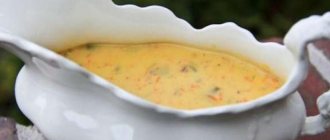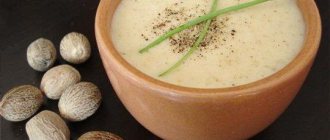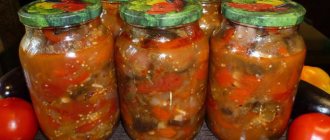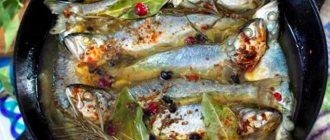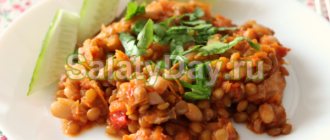While looking for new sauces for dishes, I came across a recipe for Bulgarian lutenitsa, which can easily be prepared at home. Queen Lyutenitsa, that’s what they say about the seasoning in Bulgaria. There, preparing the sauce is a whole event, a long-standing tradition started by great-grandfathers, when the whole family gathers. And then the aroma of baked pepper floats through all the houses. Once you try it, you will want to make the sauce for future use. The word "lyutenitsa" means "fiercely, sharply." In fact, the sauce doesn't have to be spicy. There are recipes with a delicate, light taste; this snack is eaten as a sandwich.
There are several variations of the Bulgarian appetizer, which is based on baked sweet peppers. There should always be more bell pepper, but you are free to choose the ratio of the remaining components yourself. Add carrots, eggplants, hot chili peppers. Vegetables are finely chopped or pureed. But the end result is a magnificent thick sauce, or adjika, as lyutenitsa is also called, which is spread on bread, served with meat, and spaghetti. Yes, serve it with any dish, except tea, and the sauce will be appropriate everywhere.
Helpful advice! Remove the skin from the roasted vegetables. To make this easy and quick when removing from the oven, proceed in three ways:
- Immediately place them in the pan and cover with a lid.
- Place in a regular plastic bag, tying it tightly.
- Wrap in foil.
And let it cool in this position.
Classic recipe
Bulgarian-style Lyutenitsa, the recipe for which is considered a classic, is prepared exclusively from sweet peppers and tomatoes with the addition of refined oil, salt, dry black pepper and sugar. No other spices are added to the classic lyutenitsa; it is believed that the aroma of baked sweet peppers should not be interrupted by anything. There should be 2 times more pepper than other vegetables, and it is better to take slightly overripe tomatoes.
What ingredients will you need?
For the classic version you need:
- sweet red pepper - 1.8 kg;
- tomatoes - 900 g;
- deodorized oil - 35 ml;
- salt - 28 g;
- sugar - 35 g.
The recipe is provided below.
Step-by-step cooking process
When preparing national dishes, you must strictly follow the rules and sequence of work:
- Wash the tomatoes and pour boiling water over them for a few minutes. Drain the hot water and immediately rinse the tomatoes with ice water - this will help remove the skins quickly. Remove seeds and white veins.
- Using a blender, puree the tomatoes, pour it into a saucepan and slowly simmer, evaporating the water.
- Bake the whole peppers in a preheated (approximately 180 °C) oven until soft and black crust appears. After removing the pepper from the oven, cool it in a covered pan so that the skin moves away from the fleshy part. Remove peel and seeds. Grind the pepper into a puree.
- Add the pepper puree to the boiled tomatoes and, stirring continuously, cook over low heat for about 15 minutes. Stir sand, salt and refined oil into the sauce. Boil for another 5 minutes. Adjust the amount of salt and sugar to taste.
- If the lyutenitsa was prepared for storage, then it should be placed in sterilized jars, tightly screwed with lids scalded with boiling water and wrapped until cool.
Serving rules, decoration, what to combine with
Bulgarian-style Lyutenitsa is served both hot and cold. When hot, it can accompany meat, chicken or rabbit dishes as a side dish, or be a sauce for pasta, rice, dumplings or manta rays. When cold, it is served spread on a toasted piece of bread or as an appetizer, garnished with grated cheese and chopped parsley.
Product Description
This is a thick vegetable paste, red-orange or red-brown in color, with a strong aroma of sweet pepper. The taste is sweet or sweet and sour, rarely spicy, with a slight hint of spicy vegetables and/or herbs included in the composition. It has been a traditional Bulgarian dish for many years.
Lyutenitsa is special in that recipes for its preparation, both at home and in factories, always involve the use of pre-baked peppers and eggplants. Baked briefly, but at high temperature and until the skin is charred. Originally this was done on a metal sheet or grate set low over hot coals. Now the Bulgarians have a special device called “Chushkopek” *, but we can use a barbecue, grill, or oven, gas or electric.
*Chushka is one of the names of red sweet pepper in Bulgarian. “Chushkopek”, accordingly, is a stove for roasting peppers.
What do you eat Bulgarian lyutenitsa with?
Above we used the expression “Bulgarian dish” in relation to lyutenitsa. Indeed, in a sense, this is an independent dish - the appetizer can be eaten simply spread on bread, scooped up with nachos, unleavened chips or a piece of tortilla.
Also, Bulgarian sauce lyutenitsa is suitable for the following products:
- Meat and meat products.
- Bird of any kind.
- Fish of any kind.
- Pasta.
You can also season various stews with lyutenitsa.
Other recipes for preparing lyutenitsa in Bulgarian
The classic recipe is the basis for many other varieties of this sauce.
Grandmother's lyutenitsa with eggplants
In this version, eggplant is added to the classic combination of pepper and tomato, which gives the dish a delicate buttery taste.
What ingredients will you need?
The piquancy of this version of the dish lies in the original selection of raw materials:
- sweet pepper - 900 g;
- tomatoes - 900 g;
- eggplants - 450 g;
- onion - 1 head;
- leaf celery - 2 branches;
- sugar - 25 g;
- sunflower oil - 35 ml;
- salt - 25 g.
Step-by-step cooking process
It is recommended to prepare the dish in the following order:
- First you need to bake the whole peppers and eggplants until tender in any available way - in the oven, on the grill or over the fire. Cool the vegetables.
- Peel and seed the peppers and save the juice. Puree them.
- Peel the eggplants and chop with a knife.
- Cut the tomatoes and grate them. The tomato peel should remain in your hand; it is not needed.
- Heat the tomato mass in a large saucepan and evaporate the liquid.
- Add the eggplant and pepper mixture to the tomato puree and cook the lyutenitsa over low heat, stirring continuously.
- Fry chopped onion in vegetable oil. The onion itself is not added to the lyutenitsa; it is only needed to add flavor to the oil.
- Pour flavored butter into the sauce, add salt, finely chopped celery and sugar.
- Boil the lyutenitsa to the desired thickness for about 15 minutes.
- Place in jars and sterilize for about 10 minutes. Seal with lids.
Lyutenitsa with smoked paprika
Garlic and chili pepper add piquancy and heat to this sauce, and smoked paprika and dried basil add aroma.
What ingredients will you need?
In addition to the supplement in the form of smoked paprika, you will need:
- sweet pepper - 2 kg;
- tomatoes - 1.2 kg;
- eggplants - 950 g;
- fresh garlic - 3 cloves;
- hot chili pepper - 1 pc.;
- sugar - 45 g;
- salt - 45 g;
- smoked paprika - 20 g;
- dry basil - 5 g;
- a bunch of parsley;
- olive oil - 50 ml.
Step-by-step cooking process
The culinary process remains the same:
- You need to wash the peppers and eggplants, cut them in half, remove the seeds from the peppers and bake until soft.
- Peel the peppers and eggplants and chop them in any way.
- Make puree from tomatoes.
- Boil the tomato mass, evaporating the liquid.
- Combine the tomato, pepper and eggplant masses and continue to simmer slowly.
- In 20 minutes. add olive oil, salt, smoked paprika, sugar, dry basil, chopped garlic and parsley to the sauce.
- Boil the sauce until thickened, about 10 minutes.
- Place into jars and sterilize for 20 minutes. Seal with lids.
Lyutenitsa with carrots and tomato puree
A large amount of carrots in the recipe will give the dish the necessary sweetness, so no sugar is added here.
What ingredients will you need?
The main composition of raw materials is as follows:
- sweet pepper - 5 kg;
- tomato puree - 1 kg;
- eggplants - 2 kg;
- carrots - 2.5 kg;
- dry garlic - 10 g;
- crushed black pepper - 10 g;
- salt - 55 g;
- vegetable oil - 280 ml.
Step-by-step cooking process
Special cooking instructions:
- Bake whole peppers and eggplants in the oven until soft.
- Peel the peppers, remove the seeds, reserving the juice, and puree them using a mixer or blender.
- Peel the eggplants and chop with a knife.
- Boil the carrots whole, peel and grind through a meat grinder.
- Heat the tomato puree, add chopped vegetables, salt, crushed black pepper, dry garlic and hot vegetable oil.
- Cook the sauce over low heat for 10 minutes.
- Pour the hot sauce into jars and sterilize for about 20 minutes. Seal with lids. Cool and put in a cool place.
Lyutenitsa in the oven
Roasting the vegetables for a long time brings all the flavors together, and the wine gives this version of lyutenitsa a spicy kick.
What ingredients will you need?
For all its originality, this option provides only a larger number of components:
- sweet pepper - 950 g;
- tomatoes - 850 g;
- carrots - 450 g;
- onion - 250 g;
- garlic - 50 g;
- eggplants - 450g;
- hot pepper - 2 pcs.;
- sugar - 120 g;
- salt - 35 g;
- sunflower oil - 120 ml;
- white wine - 40 ml;
- grape vinegar 6% - 40 ml.
Step-by-step cooking process
The difficulty in preparation is the need to process a large number of vegetables included in the dish.
Lyutenitsa in Bulgarian. Recipe in the oven.
This is done in the following order:
- Tomatoes need to be peeled by scalding them with boiling water. Cut, remove seeds, white veins and liquid.
- The remaining vegetables need to be peeled and coarsely chopped, leaving the garlic cloves whole.
- Place carrots, onions, eggplants, tomatoes and garlic in a deep tray and bake in the oven until cooked for about 2 hours, stirring regularly so that the vegetables do not burn.
- Cut the peppers and remove seeds. Bake separately from other vegetables until soft. Cool the peppers in a covered pan. Peel them.
- When all the vegetables are ready, chop them.
- Add spices, oil, wine and vinegar.
- Divide the mixture into jars and sterilize them for at least 30 minutes. Close the jars with lids.
Lyutenitsa with hot pepper
Bulgarian-style Lyutenitsa, the recipe of which is similar to the classic one, due to the addition of hot pepper and dry chili to it, becomes more spicy in taste, which is quite consistent with the origin of the word “Lutenitsa”.
What ingredients will you need?
If there are hot peppers in the recipe, the quantitative ratio of the components of the dish changes:
- sweet pepper - 3.5 kg;
- tomatoes - 1.3 kg;
- chili pepper - 2 pods;
- grape vinegar 6% - 80 ml;
- sugar - 90 g;
- salt - 55 g;
- sunflower oil - 160 ml;
- dry chili pepper - a pinch;
- cumin - 10 g.
The recipe is below.
Step-by-step cooking process
The culinary procedure remains the same:
- The pepper should be cut, seeds and stalk removed, and grilled. Cool, peel and chop.
- The tomatoes need to be scalded, peeled and mashed into a puree.
- Boil the tomato puree in a saucepan until thick over low heat.
- The hot pepper must be removed from the stalk and baked entirely in the oven. Grind it with seeds and peel into a puree.
- Combine the tomato mass with pepper, butter, sugar, dry hot pepper and salt.
- Boil the lyutenitsa to the desired thickness. Add cumin and vinegar to the sauce before cooking.
- Place into glass jars and seal tightly with lids. Cool and store.
Lyutenitsa with apples
The apples in this recipe must be firm autumn ones, preferably sour varieties.
What ingredients will you need?
Due to the use of apples, the weights of other products change slightly:
- sweet pepper - 4.5 kg;
- eggplants - 2.3 kg;
- carrots - 900 g;
- tomatoes - 2.1 kg;
- apples - 600 g;
- sugar - 130 g;
- salt - 85 g;
- oil - 160 ml;
- thyme - a pinch.
Step-by-step cooking process
The difference in preparation in this option is small, but it must be observed:
- Peppers and eggplants need to be baked whole until soft in the oven, and then cooled.
- After freeing the peppers from peel and seeds, grind them with a blender.
- After peeling the eggplants, chop them with a knife.
- Boil the carrots, cool, peel and grind through a meat grinder.
- Scald the tomatoes, peel them and turn them into puree.
- Grate apples without peel and seeds.
- In a large container, mix all the vegetables at once and cook them, stirring, until thickened.
- Add oil, add sugar, thyme and salt. Boil for about 5 minutes.
- After sterilizing the mixture, put it in jars and close them with lids.
Lyutenitsa with green tomatoes
The color of the sauce prepared according to this recipe will no longer be classically red, but green tomatoes will give this version of lyutenitsa a sour-spicy taste. Parsley root can be replaced with aromatic parsnips.
What ingredients will you need?
Ingredients:
- sweet pepper - 2.4 kg;
- green tomatoes - 1.4 kg;
- fresh garlic - to taste;
- root parsley - 1 pc.;
- crushed black pepper - a pinch;
- sugar - 180 g;
- salt - 75 g;
- oil - 150 ml;
- grape vinegar 6% - 50 ml.
Step-by-step cooking process
In accordance with the change in the composition of the product, the order of its preparation will also change:
- Peppers and root parsley should be baked whole in the oven until soft. Remove the skins from the parsley and the skins and seeds from the peppers, reserving the juice. Grind the vegetables with a blender.
- Grind the tomatoes into puree, add all the spices. Boil for about 20 minutes.
- Add pepper, parsley, chopped garlic, crushed black pepper to the tomato mass and cook for another 15 minutes.
- Place in clean jars and sterilize for 5 minutes. Close with lids and cool.
Lyutenitsa with cheese
Lyutenitsa in Bulgaria is truly popular with the addition of siren cheese. For this recipe, you can also use hard cheese, since sirene is very similar to it.
What ingredients will you need?
The popular recipe has the shortest list of ingredients:
- sweet pepper - 5 kg;
- Sirene cheese - 500 g;
- oil - 160 ml.
Step-by-step cooking process
The cooking process is simple:
- The peppers should be roasted whole in the oven until soft.
- Cool and remove seeds and peel from peppers.
- Using a meat grinder you need to grind the peppers and cheese.
- Pour vegetable oil into the mixture, mix and immediately place in sterile jars.
- Sterilize them for about 5 minutes. Screw on the lids. Cool.
Lyutenitsa of frozen vegetables
Bulgarian-style Lyutenitsa (the recipe intended for the classic sauce can be slightly modified in winter) can also be prepared from frozen vegetables.
What ingredients will you need?
Since frozen vegetables are not as fragrant as fresh ones, to cook the dish, in addition to peppers, you have to use additional spices:
- peeled and frozen peppers - 1.4 kg;
- canned tomatoes—1.8 kg;
- onion - 120 g;
- carrots - 750 g;
- garlic - 4 cloves;
- sugar - 110 g;
- salt - 45 g;
- vegetable oil - 180 ml;
- cumin - 1 tsp.
Step-by-step cooking process
But the cooking process itself does not require much effort:
- Peel the carrots and onions, chop them and fry them in oil.
- Grind all vegetables in a blender.
- Add cumin, salt, chopped garlic and sugar to the vegetable puree.
- Cook the sauce over low heat, stirring, until desired thickness.
Lyutenitsa in a bread machine
Bulgarian-style lyutenitsa (the recipe for a modern housewife looks simpler) is prepared using kitchen appliances - a bread machine, a microwave oven, a blender. But here, too, it is necessary to pre-bake and peel the peppers and eggplants.
What ingredients will you need?
The automated processing process requires the longest list of ingredients:
- baked peppers - 10 pcs.;
- tomato puree - 300 ml;
- baked eggplants - 2 pcs.;
- carrots - 2-3 pcs.;
- onion - 1 pc.;
- garlic - 2 cloves;
- honey - 20 g;
- salt - 15 g;
- vegetable oil - 120 ml;
- cumin - a pinch.
Step-by-step cooking process
At the same time, the primary processing process becomes more complicated:
- The carrots need to be peeled, cut into cubes and cooked without water in the microwave for 5 minutes.
- Finely chop the onion and garlic.
- All vegetables should be chopped in a blender.
- Place vegetables, tomato puree and all other ingredients into the bread maker bowl.
- Set the bread maker to the “Marmalade” or “Jam” program.
- At the end of the program, repeat it again.
- Place in clean small jars and, after sterilizing them, close them tightly with lids. Place in a cool place.
Lyutenitsa with eggplants
Lyutenitsa is prepared with eggplants just as often as without them, so it’s even difficult to say which of these options is considered more traditional.
What you need (for 1.25-1.5 l):
- eggplants – 0.5 kg;
- pepper – 1 kg;
- tomatoes – 0.5 kg;
- hot pepper – 1 pod;
- salt – 7.5 g;
- sugar – 10 g;
- vegetable oil – 80 ml;
- table vinegar (9 percent) – 40 ml.
How to cook:
- Cut the eggplants in half, sprinkle with salt, after 10 minutes, rinse and pat dry with a napkin. If this is not done, they will be bitter.
- Bake the peppers and eggplants and cool.
- Peel the peppers and scrape out the pulp from the eggplants. Chop finely and process with an immersion blender.
- Pour boiling water over the tomatoes and remove the skins. Cut the fruit into slices and grind using a blender.
- Add finely chopped hot pepper to the tomato puree. Place the mixture on low heat. Reduce by at least a third, preferably by half.
- Add the crushed pulp of eggplants and chushek. Bring to a boil.
- Add the remaining ingredients and cook for 8-12 minutes.
- Place in prepared container and roll up.
Eggplants in lyutenitsa prepared according to this recipe do not interrupt the taste of pepper, but complement it very favorably.
Useful tips and tricks
In cooking there are always many solutions to the same problem. But the basic rules remain the same.
Rules for sterilizing cans of canned vegetables.
Place a thick cloth on the bottom of a large saucepan, place jars of preserved food and fill with hot water up to the hangers. Place the pan on the stove, close all the jars with lids scalded with boiling water and boil the canned food. After sterilization is complete, remove the jars from the water, scald the lids again and close the jars with them. Wrap the preserved food in thick warm material until it cools completely.
Sterilization time depends on the volume of the jars:
| Capacity | Sterilization time |
| less than 200 ml | 5 minutes. |
| 200 ml | 10 min. |
| 500 ml | 12 min. |
| 700 ml | 15 minutes. |
| 1 l | 20 minutes. |
Useful tips
The taste of lyutenitsa significantly depends on the quality of vegetables, so you need to choose thick-walled red peppers, fleshy tomatoes and sweet carrots:
- It is better to bake eggplants whole, then they will be more juicy. To prevent the eggplants from bursting during baking, they must be pierced with a knife in several places. If you bake eggplants in halves, their texture will be drier.
- When baked, the pepper will retain all its juice inside, which is used in the further preparation of the sauce.
- The amount of sugar and salt can be varied to taste.
- You need coarse salt, not iodized.
- Bulgarian housewives use grape vinegar in cooking, but it is acceptable to use apple or wine vinegar, but not balsamic.
- Cumin can be omitted or replaced with cumin if desired.
- The texture of lyutenitsa depends on the method of chopping the vegetables: chopping with a blender makes the sauce smoother and silkier, and if the vegetables are chopped with a knife or turned through a meat grinder, the texture will be uneven and the sauce will be more like vegetable caviar.
- If you plan to use lyutenitsa immediately or within a week, then there is no need to sterilize it, but should be stored in the refrigerator in a closed container. And if the sauce is prepared for the winter, then the jars must be sterilized and stored in a cool place.
How to prepare lyutenitsa for the winter at home
At the beginning of preparing lyutenitsa, we need to wash the tomatoes, eggplants and lettuce peppers under running water.
Next, we will bake the little blue ones in the oven over medium heat.
In terms of time, large-sized fruits are baked, usually for half an hour.
Baked eggplants need to be placed under pressure so that excess liquid drains from them.
We need to remove the skin from the cooled baked eggplants.
Grind the eggplant pulp in a blender or meat grinder.
At the next stage, we bake the lettuce pepper on a baking sheet in the oven for twenty minutes.
During the baking process, you need to open the oven several times and turn it over so that it bakes evenly.
Place the baked peppers in a deep bowl and cover with cling film.
The peppers should “sweat” under the film for ten minutes. After this, we easily remove the outer films from them and remove the centers.
Grind the peeled pulp using a blender or meat grinder.
In order for the consistency of the finished lyutenitsa to be pleasant and uniform, we also need to remove the skin of tomatoes. To do this easily, cut the skins of the tomatoes crosswise and blanch them for 2-3 minutes in boiling water.
After this procedure, the skin from the tomatoes can be easily removed by hand.
We also grind the peeled tomatoes as well as the blue peppers.
Pour the tomato puree into a stainless steel container, bring to a boil and cook over medium heat, stirring occasionally, for half an hour.
While the tomato puree is boiling, we peel the garlic, and remove the seeds and stem from the hot pepper.
We grind.
Add chopped lettuce and blue peppers to the tomato puree boiled to the desired thickness, mix and bring the mixture to a boil.
Then, add sugar, salt, hot pepper and garlic and simmer our preparation over low heat for another ten minutes.
Turn off the heat, add vinegar to the lyutenitsa, mix and pack hot into pre-washed 0.5 liter jars.
Cover the jars with lids and set to sterilize for fifteen minutes.
After sterilization, roll up the lids and leave the jars to cool.
Our workpiece no longer requires additional wrapping.
Yes, a lot of work was spent on preparing the Bulgarian lutenitsa, but the seasoning turned out to be a pleasant thick consistency, spicy and tasty - well, just finger-licking.
Bulgarian-style Lyutenitsa goes well with meat, fish or just fresh bread. Also, this aromatic and tasty sauce can be added to first courses.
Interesting facts about Lyutenitsa
Many Balkan and Mediterranean countries have similar dishes: in Serbia they make a spicier version, more like Caucasian adjika, in Moldova they make Tomyanka vegetable caviar, the Spanish Escalivada is a warm salad, like the Armenian Khoravac. What all these dishes have in common is the technology of preparing vegetables: they are baked over an open fire until black, then peeled and chopped. In August, during the sweet pepper harvest season, almost every yard in Bulgaria builds fire pits, on top of which they place metal sheets and bake peppers on them for this traditional sauce.
The basis of lyutenitsa is exclusively red sweet peppers with thick walls and ripe tomatoes, but often they add to this sauce:
- eggplant;
- hot peppers;
- carrot;
- onion;
- apples.
Sweet peppers contain vitamins A, C, E, K, which are antioxidants that slow down the aging process of the body, B vitamins that improve memory and resistance to stress, and minerals beneficial to the body:
- potassium;
- iron;
- manganese;
- calcium;
- zinc;
- copper;
- selenium;
- sodium;
- phosphorus.
It is red peppers that contain more carotene and capsaicin, which speed up metabolism and stimulate the process of burning fat. However, the content of all these beneficial substances in heat-treated pepper is reduced by approximately half.
Nutritional value of lyutenitsa per 100 g of product:
| Total calories (Kcal) | Proteins (g) | Fat (g) | Carbohydrates (g) |
| 114 | 1,4 | 5,8 | 13,3 |
Many culinary recipes have spread from Bulgaria throughout the world. Therefore, lyutenitsa is one of the most famous sauces that housewives prepare for the winter.
Compound
The composition of Bulgarian lyutenitsa is quite different from other similar snacks. All its charm lies in the bright, rich taste and aroma of red bell pepper. Therefore, the very minimum of spicy vegetables and spices is added to it - only to give a slight additional shade.
Bulgarian Lyutenitsa (classic recipe) includes:
- Red bell peppers are at least half of the total weight of vegetables. In Bulgaria, the “Kapia” variety of pepper is traditionally used - fleshy, dark red, with a large amount of pigment in the peel and pulp.
- Tomatoes - from a quarter to half of the total weight of vegetables.
- Eggplants - from a quarter to half of the total weight of vegetables.
Also recommended: Oyster sauce
Some housewives also include carrots, onions, and hot red pepper in Bulgarian lyutenitsa.
Spicy vegetables and spices:
- Garlic - about half a medium clove for every kilogram of vegetable mass.
- Black pepper, cumin - to taste.
- Salt - to taste.
Also, Bulgarian lyutenitsa (all recipes) includes vegetable oil and in some cases vinegar. Sometimes the recipe also includes parsley - about 0.5 tbsp. l. per kilogram of vegetables.
Variations
For those who like it spicy. Add baked hot pepper to the vegetable puree, and shortly before the end of cooking (literally a couple of minutes) add chopped garlic.
You can add carrots, tomatoes, eggplants, apples to the peppers - separately or together. The main thing is that the peppers still predominate. For those who like it sweeter: you can use carrots or apples. For a kilogram of peppers, two hundred grams will be enough. Carrots are boiled or baked, then pureed and added to the peppers before boiling. The root vegetable goes well with garlic and hot pepper. Yes, and with eggplants too. Apples can be boiled or baked. For those who like it sour. Tomatoes provide acid (if you use sour varieties). But if desired, you can add additional vinegar. Again, such lyutenitsa should be stored better. For those who like it fatter. In general, lyutenitsa is a fairly dietary delicacy; just a little fat is added to it; the vegetables are baked and not fried. But if you wish, you can add vegetable oil. Some people first fry onions, garlic and all sorts of herbs in this oil to make it more fragrant. For those who like it thicker. There are recipes with the addition of baked or boiled potatoes. We have not tried this kind of lyutenitsa, but we can assume that it is thicker and richer than the usual one. By the way, ready-made lyutenitsa, which is sold in stores, almost always has starch added.

